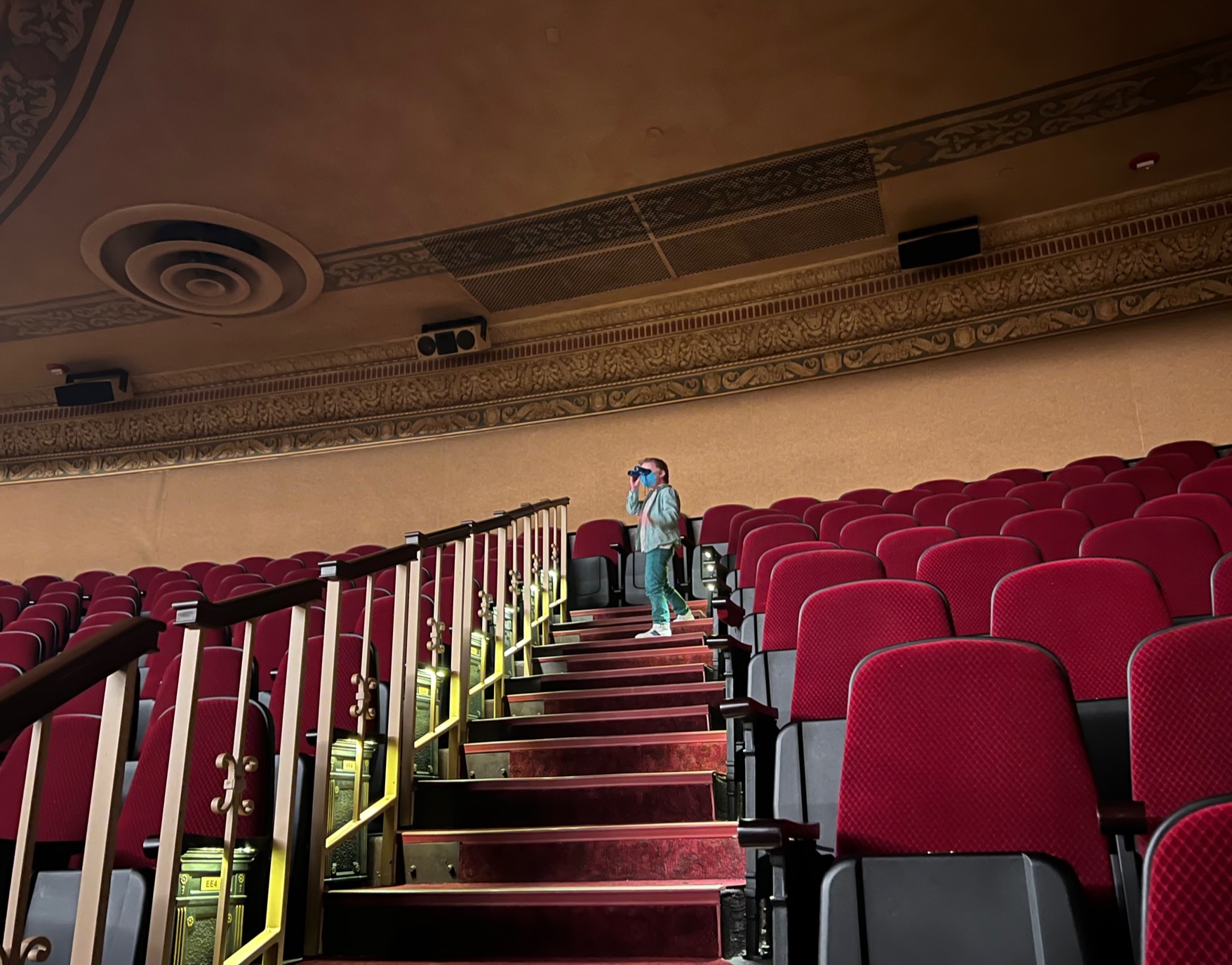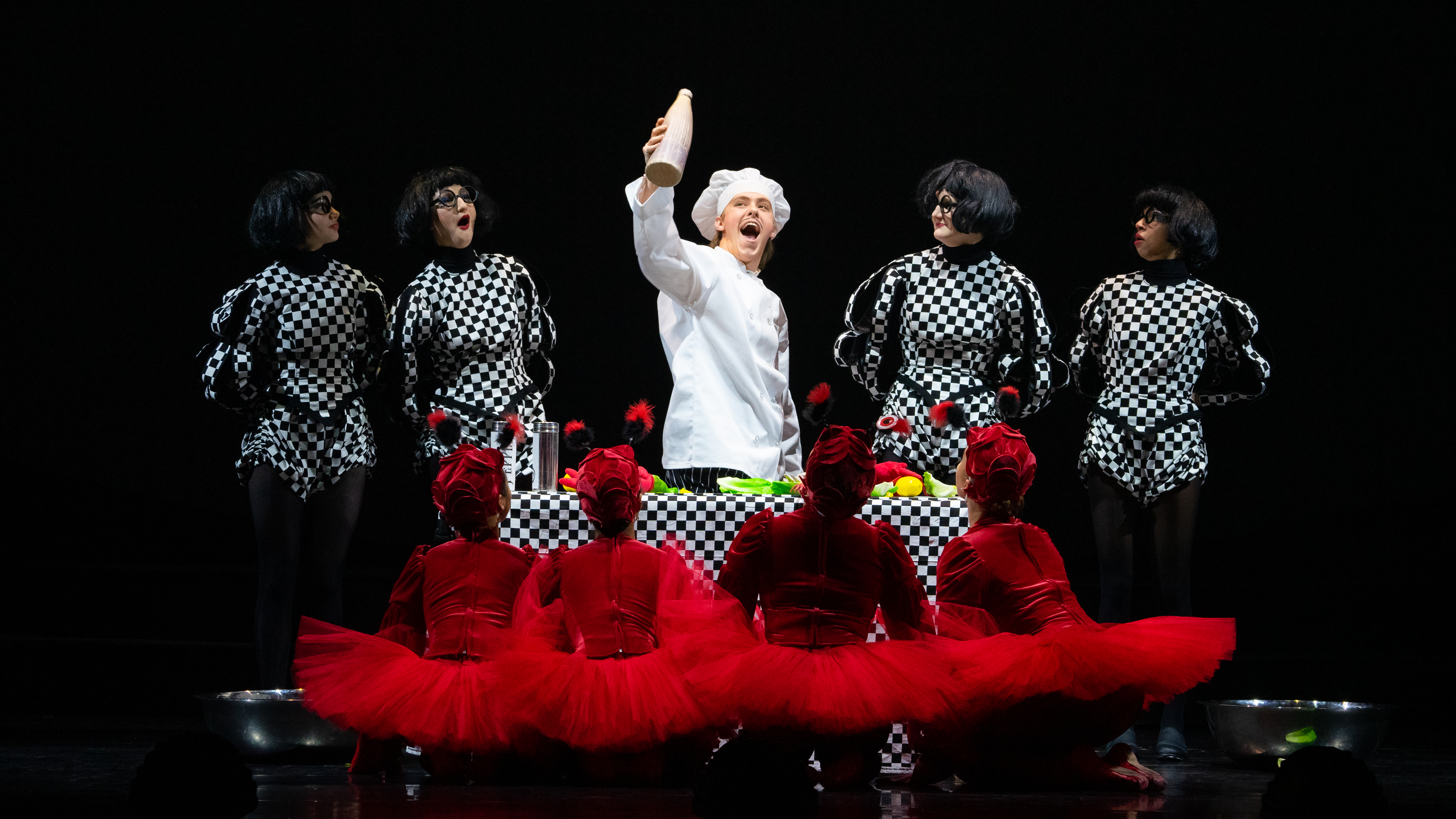Champaign Urbana Ballet’s production of The Little Mermaid was nothing like I (nor my son) had expected. No singing fish or red headed mermaid took the stage, yet the ballet performance of The Little Mermaid made a splash.
The ballet performance told the familiar love story without any dialogue. The ornate costumes, spectacular sets, and moody lighting were incredible, and the dancers were so entertaining.
On Saturday night, CU Ballet’s performance of The Little Mermaid began with crabs played by Eleanor Kraatz, Janie Lee, Janaki Raj-Underhill, and Elizabeth Seong. The four emotive dancers with red tutus and wobbly, oversized crab eyes, emerged one by one from under the closed red curtain. In Act One: Water, dancers in pale blue outfits and water dragons danced across the stage. When the Little Mermaid made her appearance, it was hard to imagine she was a mermaid at first because Grace Williams-Kim, the dancer playing the Little Mermaid, was an amazing dancer who used her legs, but other dancers lifted the mermaid, so it appeared that Williams-Kim was swimming, diving with grace, and floating through the air. Suddenly, The Prince played by James Griffiths was taken by the sea, and dancers lifted him in an epic drowning dance that ended with the Little Mermaid saving the prince — which I loved. After she saved him, the Little Mermaid caught feelings that Williams-Kim expresseed through a dreamy solo that was one of my favorite dances of the night.
An ensemble of jellyfish and dancers in pink moved danced in the Kingdom Under the Sea. Played by Hanna Laible-Seif, Emma Rypka, and Farah Willenbrock, the three mermaid sisters danced as if they were swimming, diving, and splashing like synchronous swimmers in a pool. The sisters’ gentle fluttering hands, sparkly headdresses, and spinning skirts gave the dancers a royal look, and when they completed jetés, it was impressive.
The Little Mermaid dreamt-danced with The Prince. When she awoke, she told the crabs abut her dream, and they became invested in helping her fall in love with him. The Little Mermaid whispering something into each of the crab’s ears, and my son whispered, “What did she say?” — and so did all the kids around me.
Determined to be with The Prince, the Little Mermaid swam into the dark abyss to the entrance of the magical Sea Witch’s lair for a solution. She was pulled under the curtain, and then — most dramatically — the curtain lifted to reveal a jaw-dropping transition from the whimsical underwater world to an ominous lair with dancers holding black fabric over their heads. The dark spectacular set was designed by Creative Designer and Experiential Designer Andy Warfel, and it had a gigantic net with octopus legs curled and hooked. All the sparkles gone and where fishies swam, now lost souls swayed. The Sea Witch, played by Taylor Fedderson, emerged. The Sea Witch’s costume was epic: a wild sea creature getup with green frilled bell-bottom pants and a swampy headpiece. The sea baddie was terrifying as she dance-hunched and prowled around the mermaid. Fedderson’s villainous body language was a stark contrast to the romantic dances performed thus far in the show. The Sea Witch exchanged a magical potion for the mermaid’s voice, and after agreeing, The Little Mermaid dance-cried; Williams-Kim danced in a way that showed the mermaid understood what she was sacrificing for love. The mermaid drank the orange potion, and the Sea Witch magically revealed a scarf, representative of the mermaid’s voice, which she stole from the Little Mermaid and ended the first act.

Photo by Alyssa Buckley.
The twenty minute intermission gave the audience time to buy concessions, visit the bathroom, or — if you’re my seven year old — take a gander from the very back row of the balcony of the theater.
In Act Two: Land, The Prince and the Little Mermaid, now with legs, share a funny dance in which the mermaid realized she has legs, and The Prince is like, “I know!” Griffiths’ gestures had the audience cracking up. The playful dance felt like an ode to legs which was just hilarious. Williams-Kim performed beautiful ballet as she viewed her legs with novelty, and The Prince helped her find her footing. The balletic strength of the two lead dancers was just as captivating to watch as the budding romance between the characters.
The crabs celebrated with a happy dance, but the playfulness was cut by the stark contrast of new characters clad in black and white holding big bowls — and an overzealous chef with a cleaver. The cooks dance-prepped a salad with lettuce, lemon, and plastic life-size crabs, and the comedy of watching the silly crabs (who the audience loved at this point) watching a chef cook plastic crabs was on point. Choppy, boppy dance moves mimicked the chef’s chopping knife, and the cooking dance of shakes, bops, and chops was so very entertaining.

Photo by Claire Daly.
The chef Monseigneur Carnage du Crabbe was played by Elijah Ochs totally stole the show with his ridiculous chopping and his cleaver-happy glee. The story moved to a sophisticated ballroom with cardboard servants called Snooty Chaps. Dancers in purple gowns and dancers in suits filled the stage twirling about in pairs in a long ballroom dance sequence, and the formality in the dancers’ ballet matched the dancers’ high society costumes. The Prince in his regal outfit had exciting jumps and amazing dance moves, but during his solo, it became clear that he was missing a dance partner. When the Little Mermaid joined the party with a short white gown, the couple had an affectionate dance with smiles, hand holding, and impassioned lifts. The duet ended with The Prince lifting the Little Mermaid into an awe-inspiring pose where she was off the ground and his arms were outstretched.
The slapstick Monseigneur Carnage du Crabbe returned with his minions, and an absurd crab fight ensued. Brooms versus crabs was not the fight that I signed up to watch, but I am so glad I got to see it. At one point in the fight, Ochs leapt into a perfect split so high above the stage that it was nearly over a dancer’s head.
The show returned to the lovers dancing together. The Prince had impressive leg extensions, and the Little Mermaid danced en pointe — until the intense arrival of the Sea Witch who wore a red cape. The Sea Witch wrapped The Prince with the scarf, and for me, the symbolism was easy to understand, but my young son whispered, “What’s happening?” The Prince willingly answered the seawitch’s siren, and once again, the mermaid protagonist wept.
Entering with his four sidekicks, the chef was quickly captured by the Sea Witch who replaced his chef hat with a liturgical headdress, so he could preside over the wedding. The Sea Witch and The Prince nodded yes to the chef-priest, and most dramatically, the Sea Witch ripped off her red cape and her green-blue sea creature costume was revealed. The lights dramatically strobed, and the evil seawitch captured the lovers in her net. The show ended with an heroic finale of dance fighting, taking the scarf back, and the return of the Little Mermaid’s voice. The chef-priest presided over the wedding we were rooting to see all show long. The production finished with an amazing group dance number and cannons shooting out glittery silver ribbons over the audience.
The one thing I thought was odd was that, at one point in the show, the three small dancers were each put on a leash? The three mermaid sisters hooked leashes to the little kids’ necks and walked behind them. I guess the little ones may have needed guidance onstage, and maybe the mermaids had the kids as transport, but to me, seeing leashed children was kind of cringe.
That said, I admired the costumes, the music, and all of the ballet dancing of CU Ballet’s production of The Little Mermaid. Ballet was the perfect medium for this fairytale. Before this show, when I thought of The Little Mermaid, I thought about singing fish and Ariel, but the ballet version had neither. Instead, the ballet highlighted that the Little Mermaid didn’t need her voice; she only needed her legs — the same as the CU Ballet dancers.








